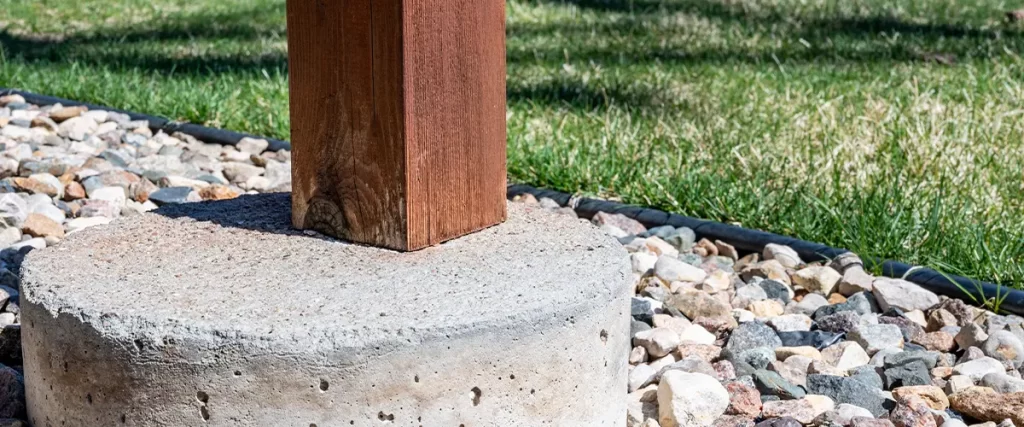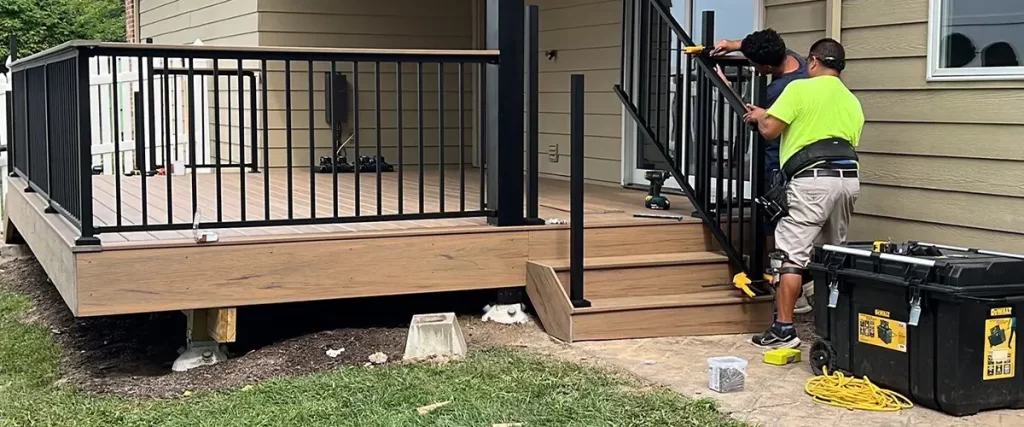If you live in or around Omaha, you already know how unpredictable our soil can be. One season it’s dry and cracking, the next it’s saturated and swelling. And if you’re thinking about building a deck or already have one, this shifting ground can be a real headache.
The culprit? Expanding clay soil. It’s a silent force that slowly compromises your deck’s footing and foundation stability if not handled right.
This guide is here to help you figure out the best approach for long-lasting Omaha deck footing solutions. Whether you’re starting from scratch or repairing an old structure, we’ll walk through everything you need to know, no fluff, just useful info you can actually use.

Why Expanding Clay Soil is a Big Deal in Omaha
Let’s start with the elephant in the yard: clay soil deck challenges are very real here. Omaha’s natural soil profile is heavy in expansive clay, especially in neighborhoods that were developed on what used to be farmland or river-adjacent terrain.
Clay soil holds onto water like a sponge. When it gets wet, it swells. When it dries out, it contracts. This creates a cycle of movement that puts a ton of stress on your deck footings. If you’ve ever noticed cracked sidewalks or uneven patios around your neighborhood, that’s the same problem.
So, when your deck footing isn’t designed to deal with those soil shifts, you’re signing up for:
- Warped or sloping decks
- Cracked footings
- Loose or unstable posts
- Structural damage over time
All of which means expensive repairs later.
Understanding Your Foundation Options
Before we dive into what works best, let’s quickly go over the different types of deck footings so you know what’s out there.
Traditional Concrete Footings
This is the classic option most homeowners think of. A hole is dug, concrete is poured, and a post is anchored to it.
Pros:
- Readily available
- Relatively affordable
- Good for shallow, stable soil
Cons:
- Not ideal for expansive clay
- Can crack and shift over time
- Requires deep digging to reach below the
- rost line
Helical Piers
These are like giant metal screws that twist deep into the ground. Think of them as anchors for your deck.
Pros:
- Excellent for clay and unstable soil
- Installed quickly with no concrete
- Can go deeper than the frost line
Cons:
- Requires professional installation
- Higher upfront cost
Diamond Piers
These use a pre-cast concrete head and multiple long steel pins that are driven into the ground at angles.
Pros:
- Spreads the -load effectively
- Resists heaving from moisture
- Fast to install
Cons:
- Not as common (limited availability in some areas)
- Higher cost than traditional concrete
Precast Concrete Footings (Deck Blocks)
Set on top of compacted gravel or a concrete pad.
Pros:
- Quick to install
- No curing time
- Great for small or temporary decks
Cons:
- Not great for shifting soil
- Not permitted for elevated or heavy-load decks in many local codes

So, What’s the Best Deck Footing for Clay Soil in Omaha?
If you’re in Omaha and dealing with expanding clay soil, the safest long-term bet is helical piers. These are specially designed to deal with shifting ground. They reach deep into more stable soil layers, bypassing the troublesome topsoil altogether.
Even better? They’re not affected by freeze/thaw cycles because they’re installed below the frost line. This gives your deck a rock-solid base year-round.
Diamond piers are also a solid second choice, especially for mid-size decks or projects where appearance and load distribution matter. Traditional concrete footings can still work, but they must be done right deep, reinforced, and with proper drainage in mind.
Tips for Improving Foundation Stability in Clay Soil
Here are a few extra steps you can take to make sure your deck footings last:
- Install Footings Below the Frost Line (at least 42” deep in Omaha)
- Use Gravel for Drainage at the base of the footing to keep water away
- Backfill with Granular Fill instead of clay to reduce swelling pressure
- Slope the Ground Away from the Deck to prevent pooling
- Seal the Deck Posts where they meet the footing to reduce moisture wicking
All of these may seem minor, but when combined, they make a huge difference in your deck’s stability.
Top Manufacturers of Deck Footings Built for Clay Soil
Reliable deck footing starts with trusted products. The best manufacturers offer time-tested engineering and products built for performance in tough conditions.
- Techno Metal Post
Specializes in helical piers that perform extremely well in expansive and saturated soils. - Diamond Pier
Known for their patented pin pile system designed to resist frost heave and soil movement. - Simpson Strong-Tie
Offers a range of footing solutions and connectors built to handle varying soil types. - Bigfoot Systems
Makes concrete footing forms that help with water drainage and load distribution. - Surefoot Footings
Australian-origin footing tech that’s designed for reactive soil environments like clay.
Why Working with Our Expert Team Matters
We’ve been installing Omaha deck footing solutions for years, specifically for homes battling clay-heavy soil. Our team doesn’t just dig and pour we engineer footing systems that last, tailored to your exact backyard conditions.
We take time to assess your soil type, moisture levels, deck size, and load. It’s this attention to detail that saves you money in the long run. No shortcuts. No guesswork. Just solid results.
If you’re ready to finally get your deck project done right with zero stress contact us of pros at (402) 369-5724. We’ll walk you through your options and give you a clear plan that works with your budget and timeline.

Frequently Asked Questions
How deep do deck footings need to be in Omaha?
At least 42 inches to get below the frost line. But if you’re dealing with expansive clay, deeper may be better, especially with helical piers.
Can I pour concrete footings in wet clay soil?
You can, but it’s risky. If the clay is too wet, the hole can collapse, and the concrete might not cure properly. It’s better to wait for dry conditions or use piers.
Do I need a permit for deck footings?
Yes. Omaha has specific building codes for decks, including depth and spacing requirements for footings. Always check with the local permit office before starting.
Are deck blocks okay for clay soil?
Not really. Deck blocks sit too shallow and can shift or sink in clay soil. They’re better suited for non-permanent or low-load decks.
Can I install helical piers myself?
Nope. They require special equipment and trained technicians to install properly. But the payoff in stability is worth it.
Will clay soil always ruin a deck over time?
Not if you plan ahead. With the right footings and drainage systems, you can build a deck that stays level and strong for decades.
What happens if I ignore soil movement?
You’ll likely see uneven posts, wobbly railings, and possibly structural damage that could lead to a total rebuild. Not worth the risk.
What’s the most cost-effective option long term?
Helical piers may cost more upfront, but they prevent future repair costs, making them the most cost-effective choice over time.
Ready to Build Smart?
At the end of the day, you’re not just building a deck, you’re building an investment in your home. And when you’re dealing with Omaha’s expanding clay soil, it pays to do it right the first time.
Our team of professionals knows the local challenges inside and out. We’ve tackled everything from sloping yards to post-sinking nightmares. If you’re ready to get started on a strong, secure, and stunning deck, contact us at [cgv tel] to start your deck building project. We’ll take care of the heavy lifting literally.
Need help customizing your design or are not sure where to start? Reach out anytime, we’re happy to answer questions and help you build with confidence.
